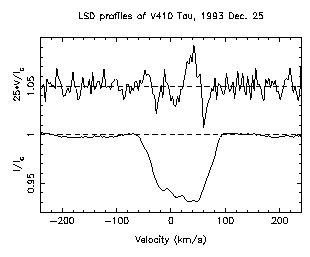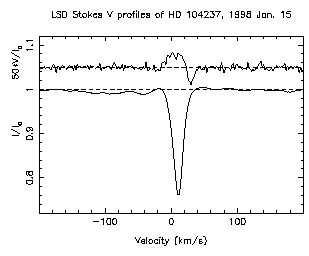

Magnetic field is an important parameter in many astrophysical
problems and at virtually all spatial scales, from interstellar dust grains to planets
and stars, and to galaxies and clusters of galaxies. In stars
in particular, they play a crucial role on their interior, their atmospheres and their
circumstellar environment, by influencing (in sometimes a rather drastic way) the
transport processes of chemical elements and angular momentum.
Studying the topology of magnetic fields, and in particular their
large- and small-scale structures, can first help us understand their
physical origins, whether they are produced whithin stellar plasma
through hydrodynamical processes (dynamo fields) like that of the
Sun, or represent a fossil remnant from a previous evolutionary stage (fossil fields) like
those of chemically peculiar stars. It also helps understanding the potential impact
of these magnetic fields on long-term stellar evolution.
Using high resolution echelle spectropolarimeters (like that of the
MuSiCoS
spectrograph) and cross-correlation techniques such as
Least-Squares Deconvolution, one can detect stellar magnetic fields through
the Zeeman signatures they generate in the shape and
polarisation state of spectral line profiles (the
Zeeman effect).
Zeeman-Doppler imaging (ZDI) works best for moderate to ultra-fast rotators,
for which circular polarisation signatures of individual unipolar
magnetic regions are associated to different Doppler
velocities and thus no longer mutually cancel as in conventional polarimetric
methods. This method was successfully used to obtain the first
direct detection (i.e. from spectropolarimetric data) of magnetic fields
in cool stars other than the Sun.
Although small (with a typical relative size of 0.1% of the unpolarised continuum), Zeeman signatures from surface magnetic fields of cool active stars have now been detected with ZDI in about 20 objects, from pre-main sequence (2 wTTS and 1 cTTS) to main-sequence (3 ZAMS objects and 1 dMe star), to red-giant branch stage (12 RS CVn system, 1 FK Com star). Below is an example of such circular polarisation (i.e. Stokes V) signatures (upper curves) for the very young weak-line T Tauri star V410 Tauri (left panel) and for the evolved FK Com giant YY Men (right panel). Note that these Stokes V signatures show several sign reversals indicating that the underlying field structure is probably quite complex.

 © MNRAS
© MNRAS
Monitoring such Zeeman signatures throughout a full stellar rotation cycle allows one
to map the detailed structure of the vector field topology and
study the way dynamo processes operate in convective zones of
cool stars.
Magnetic chemically peculiar (Ap) stars also feature large-scale field structures often modeled as offcentred dipoles. ZDI can also be used to detect line profile circular (Stokes V) and linear (Stokes Q and U) polarisation Zeeman signatures generated by these large-scale field structures. Below is an example of Stokes V (left panel, upper curve) and Stokes U (left panel, upper curve) line profiles in the particular case of the Ap star 49 Cam (note the different amplification factors for the circular and linear Zeeman signatures).


Monitoring such Zeeman signatures throughout a full stellar rotational cycle should allow
one to study how the underlying large-scale magnetic topologies differ from simple
dipolar structures, and thus test in detail the fossil origin currently invoked for
these field structures.
There is very likely other classes of non-degenerate magnetic stars than the only two we know of at the moment (solar-type and chemically peculiar stars), and probably other forms of stellar magnetism as well. We indeed have ample indirect evidence that magnetic fields are likely present at the surface of stars of other types. Magnetic fields in accretion discs for instance (produced through some kind of shear-flow dynamo) are now invoked by many astronomers to explain the anomalously high viscosity observed in such objects, but have not been detected yet. Hot stars (O stars, Wolf-Rayet stars) and warmer ones (Ae/Be Herbig stars, Be stars, A/B supergiants) are also very good candidates for instance, for which magnetic fields are very often invoked to explain the azimuthal structuration observed in their strong winds. The recent field detection obtained in the Herbig Ae star HD 104237 (see below) is a direct confirmation of this point.

A detailed monitoring of how the detected Zeeman signature is rotationnally modulated is
presently undertaken in order to study the topology of the
associated field structure and therefore its probable physical origin.
We can nevertheless say already that, given the high level of intrinsic variability we
observe for this star, it is unlikely that the field is fossil. A solar-type dynamo field
on the other hand would be highly surprising as this star does not trigger a vigorous
enough convection. We speculate that such a field may also be produced through a
shear-flow dynamo within the upper atmospheric layers that suffer
strong rotational braking from the magnetised wind.
 Budding E., Carter B.D., Mengel M.W., Slee O.B.,
Donati J.-F.,
``A Radio and Optical Study of the Active
Young F Star HR 1817 (=HD 35850)'' (2002) PASA 19, 527
Budding E., Carter B.D., Mengel M.W., Slee O.B.,
Donati J.-F.,
``A Radio and Optical Study of the Active
Young F Star HR 1817 (=HD 35850)'' (2002) PASA 19, 527
 Shorlin S.L.S, Wade G.A., Donati J.-F., Landstreet J.D.,
Petit P., Sigut T.A.A., Strasser S.,
``A sensitive search for magnetic fields in
B, A and F stars'' (2002) A&A 392, 637
Shorlin S.L.S, Wade G.A., Donati J.-F., Landstreet J.D.,
Petit P., Sigut T.A.A., Strasser S.,
``A sensitive search for magnetic fields in
B, A and F stars'' (2002) A&A 392, 637
 Donati J.-F., Babel J., Harries T.J., Howarth I.D., Petit P., Semel M.,
``The magnetic field and wind confinement of
theta 1 Orionis C'' (2002) MNRAS 333, 55
Donati J.-F., Babel J., Harries T.J., Howarth I.D., Petit P., Semel M.,
``The magnetic field and wind confinement of
theta 1 Orionis C'' (2002) MNRAS 333, 55
 Donati J.-F., Wade G.A., Babel J., Henrichs H.F.,
de Jong J.A., Harries T.J.,
``The magnetic field and wind confinement of
beta Cephei: new clues for interpreting the Be phenomenon?''
(2001) MNRAS 326, 1265
Donati J.-F., Wade G.A., Babel J., Henrichs H.F.,
de Jong J.A., Harries T.J.,
``The magnetic field and wind confinement of
beta Cephei: new clues for interpreting the Be phenomenon?''
(2001) MNRAS 326, 1265
 Donati J.-F. ,
``Stellar magnetic fields'',
in: Catala C., Zahn J.-P. (eds.), Aussois courses on stellar physics
(2001). Paris Observatory press, p. 173
Donati J.-F. ,
``Stellar magnetic fields'',
in: Catala C., Zahn J.-P. (eds.), Aussois courses on stellar physics
(2001). Paris Observatory press, p. 173
 Bagnulo S., Wade G.A., Donati J.-F., Landstreet J.D.,
Leone F., Monin D.N., Stift M.J.,
``A study of polarised spectra of magnetic CP
stars: predicted vs. observed Stokes IQUV profiles for beta CrB and
53 Cam'' (2001) A&A 369, 889
Bagnulo S., Wade G.A., Donati J.-F., Landstreet J.D.,
Leone F., Monin D.N., Stift M.J.,
``A study of polarised spectra of magnetic CP
stars: predicted vs. observed Stokes IQUV profiles for beta CrB and
53 Cam'' (2001) A&A 369, 889
 Wade G.A., Donati J.-F., Landstreet J.D., Shorlin S.L.S.,
``Spectropolarimetric measurements of
magnetic Ap and Bp stars in all four Stokes parameters'' (2000) MNRAS
313, 823
Wade G.A., Donati J.-F., Landstreet J.D., Shorlin S.L.S.,
``Spectropolarimetric measurements of
magnetic Ap and Bp stars in all four Stokes parameters'' (2000) MNRAS
313, 823
 Wade G.A., Donati J.-F., Landstreet J.D., Shorlin S.L.S.,
``High precision magnetic field
measurements of Ap and Bp stars'' (2000) MNRAS 313, 851
Wade G.A., Donati J.-F., Landstreet J.D., Shorlin S.L.S.,
``High precision magnetic field
measurements of Ap and Bp stars'' (2000) MNRAS 313, 851
 Donati J.-F. ,
``Surface magnetic fields of late-type stars'',
in: Butler C.J., Doyle J.G. (eds.), Brendan Byrne memorial workshop on
``Solar and Stellar Activity: Similarities and Differences'' (1999).
ASP Conf. Series, vol. 158, p. 27
Donati J.-F. ,
``Surface magnetic fields of late-type stars'',
in: Butler C.J., Doyle J.G. (eds.), Brendan Byrne memorial workshop on
``Solar and Stellar Activity: Similarities and Differences'' (1999).
ASP Conf. Series, vol. 158, p. 27
 Donati J.-F., Wade G.A.,
``On the magnetic field and circumstellar
environment of the young O7 star theta1 Orionis C''
(1999) A&A 341, 216
Donati J.-F., Wade G.A.,
``On the magnetic field and circumstellar
environment of the young O7 star theta1 Orionis C''
(1999) A&A 341, 216
 Donati J.-F.,
``Exploration observationnelle des topologies
magnétiques stellaires''
(1998) Habilitation à diriger des recherches, Université
Toulouse III
Donati J.-F.,
``Exploration observationnelle des topologies
magnétiques stellaires''
(1998) Habilitation à diriger des recherches, Université
Toulouse III
 Donati J.-F. ,
``Surface magnetic fields of non-degenerate
stars'',
in: Kaper L., Fullerton A. (eds.), ESO workshop on ``Cyclical variability
in stellar winds'' (1998), Springer, Berlin, p. 212
Donati J.-F. ,
``Surface magnetic fields of non-degenerate
stars'',
in: Kaper L., Fullerton A. (eds.), ESO workshop on ``Cyclical variability
in stellar winds'' (1998), Springer, Berlin, p. 212
 Donati J.-F., Semel M., Carter B.D., Rees D.E., Cameron A.C.,
``Spectropolarimetric observations of active stars''
(1997) MNRAS 291, 658
Donati J.-F., Semel M., Carter B.D., Rees D.E., Cameron A.C.,
``Spectropolarimetric observations of active stars''
(1997) MNRAS 291, 658
 Catala C., Boehm T., Donati J.-F., Semel M.,
``Circular polarisation and variability in the spectra of the
Herbig Ae/Be stars I. The Fe II 5018 A and the He I 5876 A lines of
AB Aurigae''
(1993) A&A 278, 187
Catala C., Boehm T., Donati J.-F., Semel M.,
``Circular polarisation and variability in the spectra of the
Herbig Ae/Be stars I. The Fe II 5018 A and the He I 5876 A lines of
AB Aurigae''
(1993) A&A 278, 187
 Donati J.-F., Semel M., Rees D.E.,
``Circularly polarised spectroscopic observations of RS CVn systems''
(1992) A&A 265, 669
Donati J.-F., Semel M., Rees D.E.,
``Circularly polarised spectroscopic observations of RS CVn systems''
(1992) A&A 265, 669
 Donati J.-F., Semel M., del Toro Iniesta J.C.,
``The magnetic field of the Ap star epsilon UMa''
(1990) A&A 233, L17
Donati J.-F., Semel M., del Toro Iniesta J.C.,
``The magnetic field of the Ap star epsilon UMa''
(1990) A&A 233, L17
 Donati J.-F., Semel M., Rees D.E., Taylor K., Robinson R.D.,
``Detection of a magnetic region on HR 1099''
(1990) A&A 232, L1
Donati J.-F., Semel M., Rees D.E., Taylor K., Robinson R.D.,
``Detection of a magnetic region on HR 1099''
(1990) A&A 232, L1
 Donati J.-F., Semel M.,
``Zeeman-Doppler Imaging: a new option for magnetic field study of Ap
and solar-type stars''
(1990) Solar Phys. 128, 227
Donati J.-F., Semel M.,
``Zeeman-Doppler Imaging: a new option for magnetic field study of Ap
and solar-type stars''
(1990) Solar Phys. 128, 227
 Donati J.-F., Semel M., Praderie F.,
``Zeeman-Doppler Imaging of active stars II. Numerical simulation and first
observational results''
(1989) A&A 225, 467
Donati J.-F., Semel M., Praderie F.,
``Zeeman-Doppler Imaging of active stars II. Numerical simulation and first
observational results''
(1989) A&A 225, 467